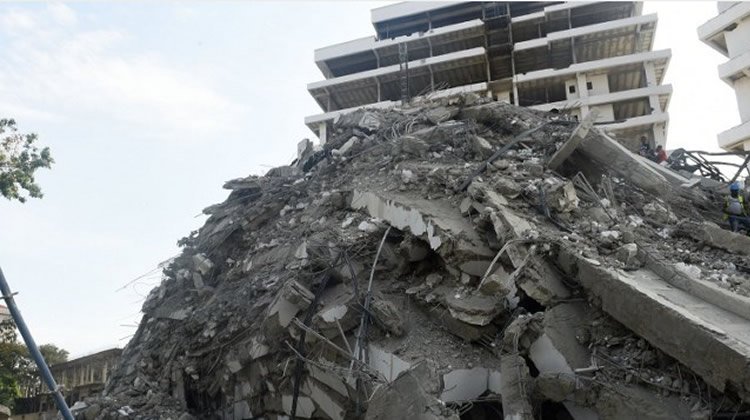
The frequency of collapsed buildings in Lagos State has become a source of worry to stakeholders who noted that concerted efforts should be made to stem the tide.
Online sources note that a building collapse refers to the failure of a structure or component to retain its structural integrity. Though building collapse is witnessed across states in Nigeria, its regularity in Lagos State is worrisome. It’s Nigeria’s former capital.
Barely three months after the collapse of a 21-storey building in Ikoyi, Lagos, which killed about 50 people, including the owner, Mr Femi Osibona, a three-storey building under construction in the Yaba area of the state caved in, killing five construction workers and a security guard.
After the Ikoyi incident, the Council for the Regulation of Engineering in Nigeria in its investigation submitted to the coroner’s inquest noted that the contractor hid “a lot of sensitive and important information.”
Also, on May 1 and barely six months after the Ikoyi building collapse, a distressed three-storey building in the Ebute Metta area of Lagos collapsed, killing 10 persons and injuring over 24 occupants. On Saturday, a two-storey building in Ago Palace Way, Isolo, collapsed. Residents of the building escaped death by a whisker when they vacated the premises after they detected the building might collapse.
On March 13, 2019, tragedy struck in the Ita Faaji area of Lagos when a three-storey building collapsed killing about 20, mostly schoolchildren and injuring about 40 people. A panel report barely a month after the incident indicated that 283 distressed buildings had been detected across the state. Building collapse cases in the state are not only limited to the above.
Figures from the Building Collapse Prevention Guild in 2020 indicated that there were over 43 incidents of building collapse in 2019. It further showed that Lagos accounted for about 39.53 per cent with a total number of 17 collapsed buildings, adding that 36,000 buildings in the state had the potential of collapsing.
Anambra State recorded six collapsed buildings while Plateau and Delta states had three each. Figures also stated that 59 per cent of the collapsed buildings in Lagos State in 2019 were existing structures while 41 per cent were under construction.
A publication by the International Institute of Science, Technology and Education, on the “Causes and Effects of Building Collapse in Lagos State,’’ revealed that the major causes of building failures were “bad design, faulty construction, overloading, non-possession of approved drawings, possession of approved drawings but non-compliance, and the use of quarks.” It added that the direct economic loss to the building owners as well as the cost of the demolition and carting away of debris from the site was over hundreds of millions.
Also, findings by the Nigerian Journal of Technology on the “Assessment of the Effects of Building Collapse Risks on the Stakeholders’’ in the Nigerian built environment carried out in 2019, revealed that loss of property, loss of reputation and integrity of the contractors, loss of lives, legal tussle among the stakeholders, were the economic, human, physical, environmental and legal risks and negative effects of building collapse.
However, a public policy organisation, Brookings Institution, revealed that between 1974 and 2019, over 221 buildings had collapsed across various states in Nigeria.
According to findings, 78.4 per cent of collapsed buildings in Nigeria were residential while 12.8 per cent and 8.8 per cent were commercial and institutional buildings respectively.
Asides from the loss of human lives, Brookings Institution stated that building collapse had displaced more than 6,000 households and an estimated loss of $3.2tn worth of property.
The PUNCH in 2020 reported that the country lost between N2.03tn and N3.05tn annually to infrastructure deficit.
Commenting on the issue, a former president, Building Collapse Prevention Guild and former president, Nigerian Institute of Building, Mr Kunle Awobodu, expressed sadness that the strong advocacy towards prevention of building collapse for many years had not yielded expected results.
He stated that the recent commercialisation and revenue generating posture of the building profession had affected the quality and standard of buildings.
Awobodu said, “Most of the developers today are building houses for sale so they are not expecting long-term results, so there is this tendency for the quality to be compromised. Most of them want to maximise profit and there is competition. For instance, if you put in too much quality material in a block of three-bedroom flat, the amount that you are going to sell it would be at the same price with the person who use a low-quality material because those who are going to buy it are just after the type of the building and would not take time to check the strength of the structure, that is to know how long the building would last before maintenance. Competition and lack of adequate supervision and monitoring of what developers are churning into the market, has created various challenges in the industry.”
He decried the non-compliance and lack of obtaining necessary building plan approval, stating that, “there are many bottlenecks that are created in the process of obtaining building plans. It can be by electronic format but the processes are frustrated by those who are within the system and are trying to reap from the delay in obtaining building plan approval. Also, developers try to avoid most of the charges and fees associated with the building plan approval process. If the charges are affordable, then more people will come forward to obtain the building plan approval. The monitoring officers do not have enough enforcement and backings to enable them to check the activities of some developers. The government officials who are also saddled with the responsibility of monitoring development are not sufficient in number for such an exercise and those who don’t willingly obey regulations or comply with the law, have the tendency to compromise government officials that are sent to monitor their property.”
Awobodu further stated that it was common practice that the basic plan approval submitted by some developers conflicted with the onsite architectural or structural design, adding that such significant variations led to defects in a building.
He called for the availability of building professionals who would checkmate onsite activities, stating that such would ensure that the theoretical plan conform to the physical building on site and prevent the frequent collapse of buildings.
He added, “Since 1978, 493 buildings have collapsed in Nigeria. Out of this figure, 305 collapsed in Lagos State alone, which accounts for 62 per cent of collapsed buildings in Nigeria. In fact, Lagos State is the epicentre of collapsed buildings in the world. It shows that the government of Lagos State really needs to come out with certain innovations that would reduce these regular or incessant building collapse cases that have also been terminating lives prematurely. This assignment can never be achieved by the government alone. There is a need for sincere collaborations within those in the government service as professionals and those in the private sectors in the build environment professions to put an end to the incessant collapse of buildings.“
Also, the Public Relations Officer, Nigerian Institute of Building, Lagos State chapter and member, Council of Registered Builders of Nigeria, Chukwurah Godfrey, stated that the unwillingness of developers and clients to engage trained and registered builders in construction was the cause of most building collapse.
He further called for the engagement of building professionals in all the processes of building construction.
Godfrey said, “Beyond blowing the whistle, we expect the government to now carry out actions. For instance, if you are seeing that the process of constructing a building is not professional or something is seemingly wrong and you blow the whistle, we expect that the government will go there, seal the place and if need be, carry out the demolition. The building that collapsed in Ebute Metta had been sealed thrice but they didn’t complete the process by demolishing the structure which would have prevented the death of about 10 persons during the collapse.”
He further said that if the government made an example of one or two persons, others would sit up.
“But it requires political will for that to take place. If it is done, things will begin to happen differently. There is hardly any week that one is not scared that a building might collapse particularly now that the rains have come,” he added.
He also called for advocacy among citizens and for government to mete out punishment to developers and its officials who decided not to do the right thing.
On his part, President, the Nigerian Institution of Structural Engineers and Fellow, Nigerian Society of Engineers, Peter IgbiniJesu, said that flouting of approval orders on buildings was the primary cause of building collapse, adding that illegal conversion of buildings, unnecessary overloading of buildings, abuse of structure were gradual causes of building collapse.
He called for the punishment of those flouting approval orders on buildings and advised occupants of residential and commercial buildings to look out for distress signs in their buildings.
The structural engineer said, “There are three things they should look out for; cracks, settlement and depression. Look out for cracks on the wall; horizontal or vertical cracks. If the crack is increasing and over time cuts across the thickness of that structural element, be it a wall, or slab, raise the alarm. Also, if you notice that there are abnormal sounds when you step on a place in the building and it has not been there before, you should raise the alarm. The third one is settlement. If this occurs there is the tilting of the building. If you notice that in your apartment, maybe you have a roll-up object that when you put it in place remains stationary, but discover that any object you put rolls to one corner that means that the building has tilted. Once you notice these three stages of distress, raise the alarm. I advise that it is better to vacate such premises.”
Copyright PUNCH.
All rights reserved. This material, and other digital content on this website, may not be reproduced, published, broadcast, rewritten or redistributed in whole or in part without prior express written permission from PUNCH.
Contact: [email protected]













